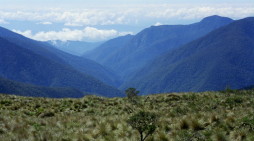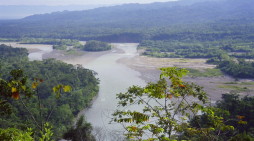Manu Biosphere reserve is situated in the remote,
southwester region of the Amazon basin.
It covers an area of one million eight hundred thousands hectares (19,000 km2
or 4.5 million acres) of untouched and pristine forest.
This area has the greatest biodiversity on earth. Because
of that the International Union for the Conservation of Nature (IUCN) declared
it in 1987 as a world heritage site.
Manu River is totally 356 km in longitude. In the native
language the word "manu" means "dark". This is definitively because of the
chocolate colour of the water, but it's not polluted.
|
The reason why it's so dark is due to a heavily load of fine sediments,
a blend of sand and silt from the headwater hills.
Photo. By boat we took our way deep in the
jungle. |
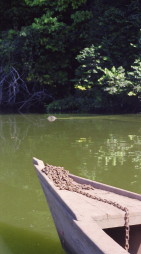 |
Photos. The entrance to wilderness in the Amazon.
The Manu area in the Amazon has a great richness of species. Over 1000 birds
have been identified, 15,000 plants and 13 species of monkey and hundreds of
other animals, not to forget the millions of insects. In Manu you could have the
"pleasure" to encounter endangered animals like black caiman, giant otter,
jaguar and of course the fearful puma.
| Photo. Manu - wild and
beautiful nature - a paradise for animals, but also for adventurers. |
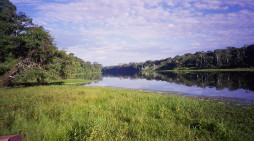 |
| Photo. Foggy morning on the river.
The humidity was extremely high. In lowland rainforest as
seen on the photo, humidity commonly range from 90 % to 95 % at ground
level. |
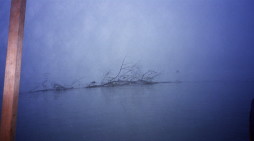 |
In the middle
of July 2001, one evening I, four Americans and our guide, had a delicious meal
in a hut. We enjoyed our time to the fullest in the middle
of the Amazon jungle near Manu in Peru. The worst thing I could think of
was to end up as dinner snacks for a puma. Especially when it is
dark these thoughts strike me since this beast of an animal usefully hunts
in the night.
Suddenly we heard someone broke some
branches outside our hut. So we heard a scream. Our hearts stopped breathing for
a while. The silence fell in the dark. We blew out the candles and
switched off our torches.
We listened carefully for some more noises. First we heard a noise that
sounded from a Peccary (pig), so we heard some other noises that we couldn't
recognize. For a while we suspected our boat drivers to play some practical
jokes with us, but finally we understood that this was real.
|
Photo. A puma looking
for prey.
(from Expediciones VILCA
www.cbc.org.pe/manuvilca
)
The Puma was near us. Our hearts beat, and we could feel the
tension!
|
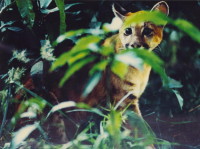 |
|
Photo. Could the red painting protect me from
the puma? |
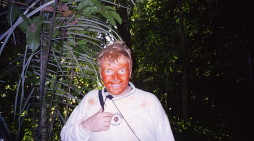 |
The sound of silence made the tension high. Our
tough and excellent guide, Ruby Huanca, ventured carefully out from the
hut. One of the Americans, Dan, told his son Nate to follow her, so she didn't
walked out there alone. Few minutes later Ruby and Nate returned.
|
Photo. Ruby, our though and top
qualified guide. She didn`t fear
anything!
Ruby was eagerly telling us that she had illuminated the red eyes of a
puma. It could also been a Jaguar, but she believed it mostly was a puma.
Anyway the predator was now gone, she said. |
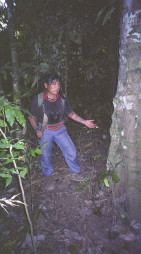 |
Since we thought the
situation was under control, we decided to walk back to our tents for
sleeping. We went slowly and looked carefully around in the dark. Just few steps outside the
hut, Dan illuminated reflexes of something red behind the bush, just 20 metres ahead
us. We stopped immediately, and took some few steps backwards. The "red eyes" was not
moving. Was the puma preparing an attack?
I guessed it was very hungry and I became little bit shaky. I took some few
steps backwards again. I wondered about running like hell back to the hut where
we ate, but since the "red eyes" was not still moving, we started to believe
that it could be something else.
| Photo. Me stumbling around in the dark trying to
avoid our unexpected vistor in the camp - the Puma. |
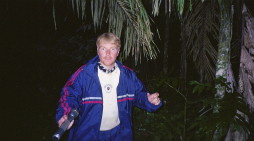 |
I encouraged the
two American girls the best I could, and said that I had heard that the puma liked especially
Americans, but don't worry too much, it only eat you once. Fortunately we reached our tents, but
not without excitement on the walk.
We stopped to listen for almost every little sound. Few minutes after I was
safe back in my tent again, I felt happy and was on the brink to fall in sleep,
then one of my American friends made me aware of that it was a big scorpion just
outside my tent.
Puma, the predator I never saw, but I really felt the
presence of it in the dark. Some information about the puma based on information
from the excellent book "Your field guide to Manu - nature's paradise"
by Arto Ovaska:
- Weight: 29 - 120 kg.
- Length of body: 80 - 150 cm (males are larger than females).
Pumas are both nocturnal and diurnal: terrestrial solitary. They eat mostly
medium and large mammals such as deer, agoutis and pacas, but also eat smaller
prey as snakes and rats.
According to Ovaska is the Puma shy and wary of people. There has only
been reported few attacks on humans, but just to let you know: pumas follow
humans discreetly from apparent curiosity. So the rest of the night went quite,
but in my dreams about the drama continued. I didn't see the puma, but
imaginations of the big cat monster are still in my mind. My feelings are mixed.
Puma is both an attraction and fear.
This article continues in part
2 - When it comes to all: was it really a puma, or was it something
else?
Read also more about Amazon
in part 3 - It's about how the puma
and other animals are linked to the mysterious Inca village, Machu Picchu.
Stein Morten Lund, 27 July 2001
Additional information
I found a big treasure in
Peru! When I decided to go to Peru, I looked forward to explore lost cities from
the past and bushwhacking in the untouched rainforest. I dreamed about finding
big gold treasures so that I could finance my holiday tour. I didn't find any
big gold treasure, but I found something bigger, the heart of the Peruvian
people. With their charm, kindness and hospitality, they melted my heart. These
memories will burn as an internal flame in my heart forever. Siempre Peru! Viva
Peru!
Information sources:
For useful background information about the Amazon, I
recommend the book "Your field guide to Manu - nature's paradise"
by
Arto Ovaska. It's about the history, rainforest, animals, tribes, precautions
and tips.
|
Photo. Ruby
Huanca, our brave guide.
She works as an independent guide (freelance).
She can be contacted for information and booking on e-mail: rubyhuanca@hotmail.com. |
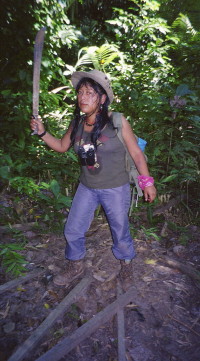 |
General information and bookings for an exciting tropical tour:
Expediciones VILCA
VILCA EXPEDICIONES
Plateros 363 Telephone: 51
84 244751
Fax: 51 84 251872
Mobile phone: 9681002
e-mail: manuvilca@terra.com.pe
Website: www.cbc.org.pe/manuvilca
Base of
operation: Santa Mónica Jose María Arguedas J 9, CUSCO - PERU
Conservation about nature and wildlife:
As
more people visit the jungle in Amazon and learn about its flora and fauna, more
people will become involved in the work for conservation. Local people and
governments will also see that the long term value of the rainforest may be
worth more if the rainforest remains intact.
Peru currently has roughly 5 percent of its territory
protected by a system of around 50 national parks, reserves, sanctuaries and
other designated areas, a process which has developed extremely well since it
was begun in the 1960s.






